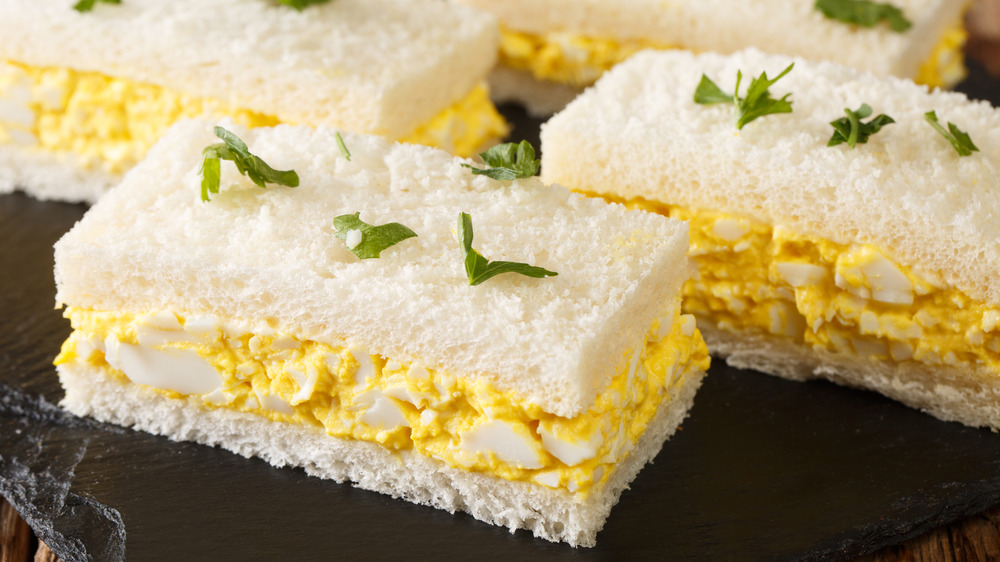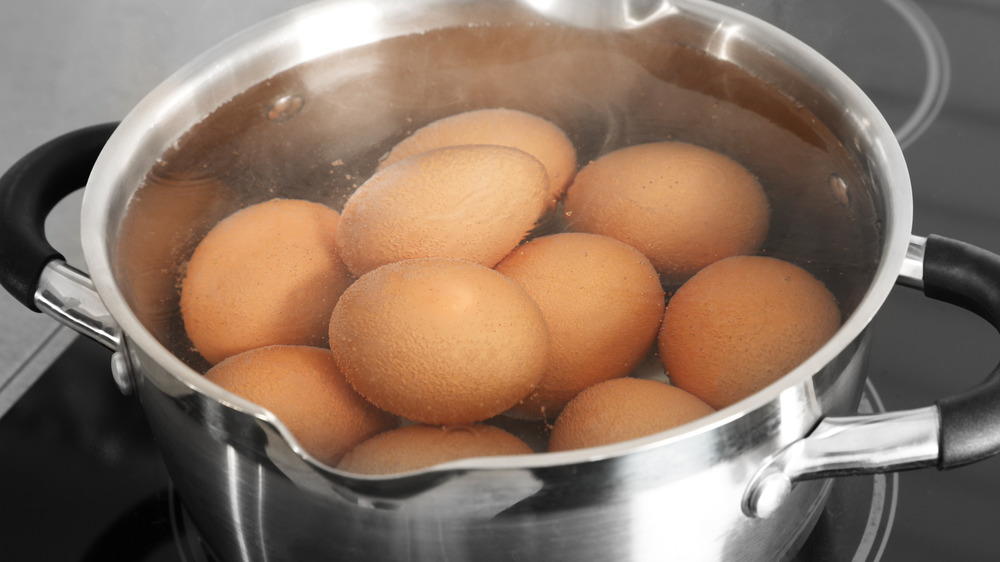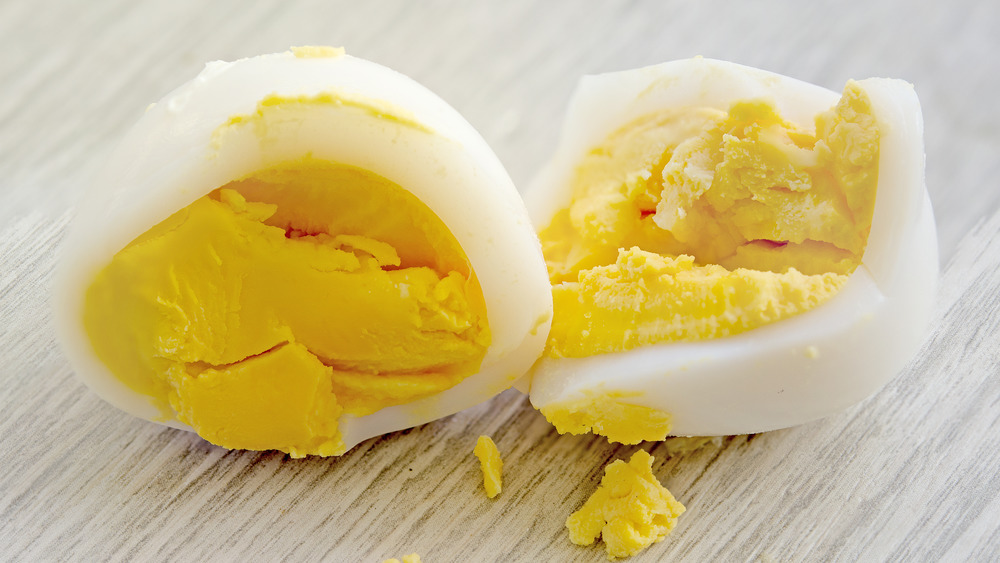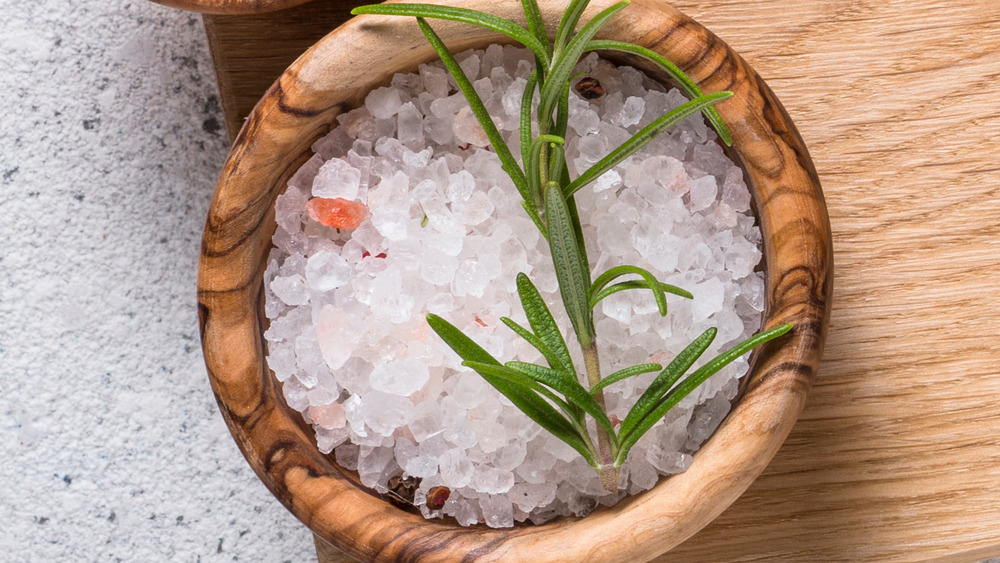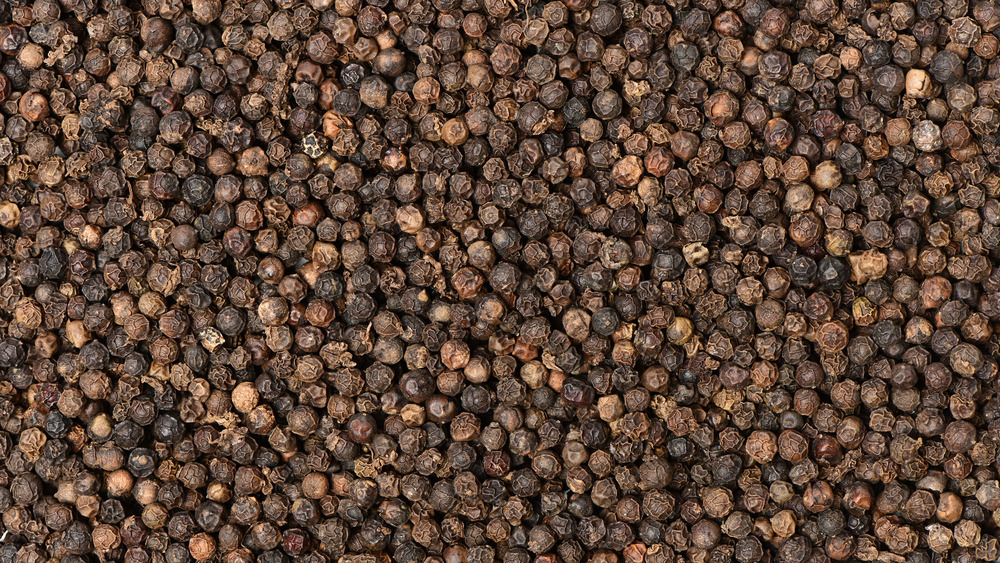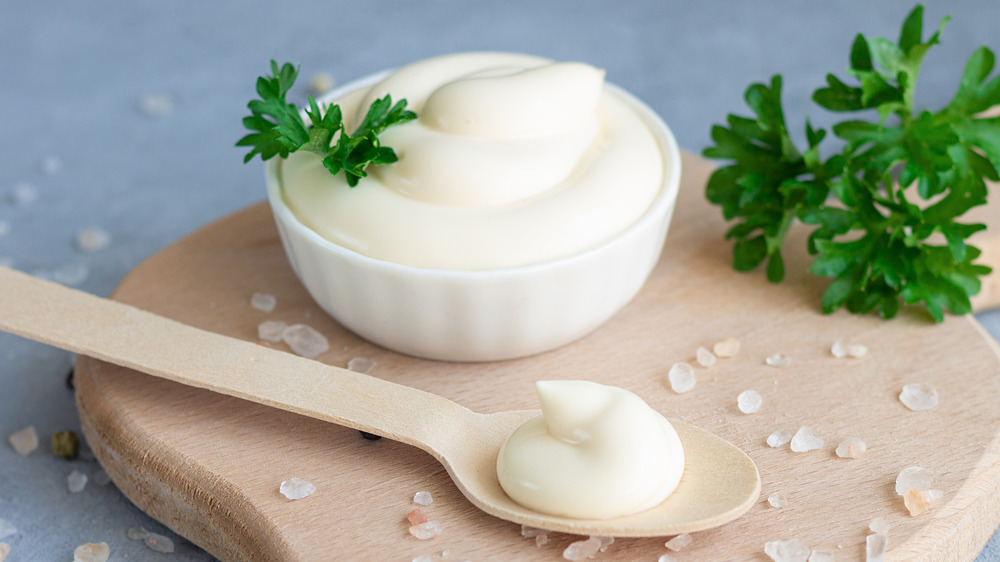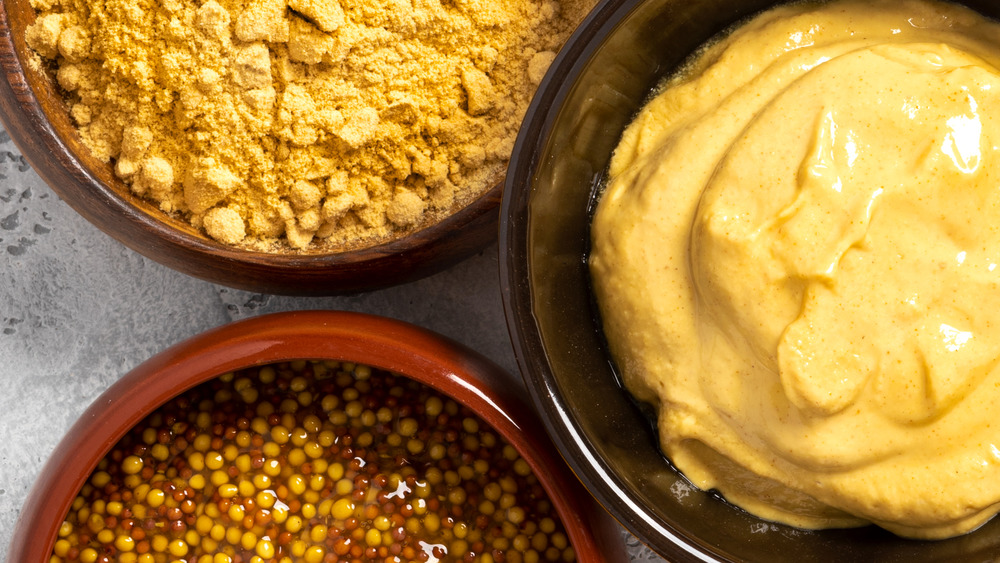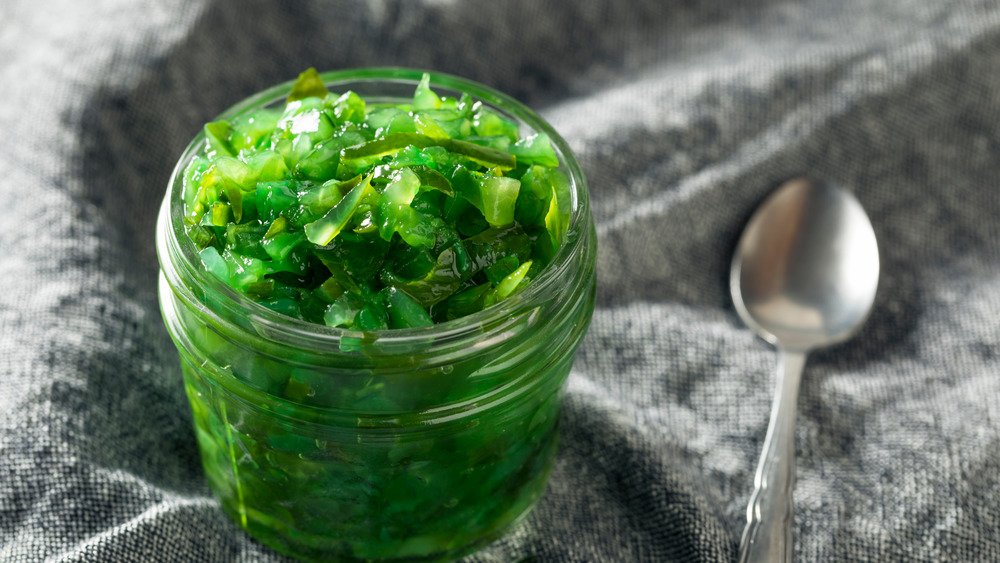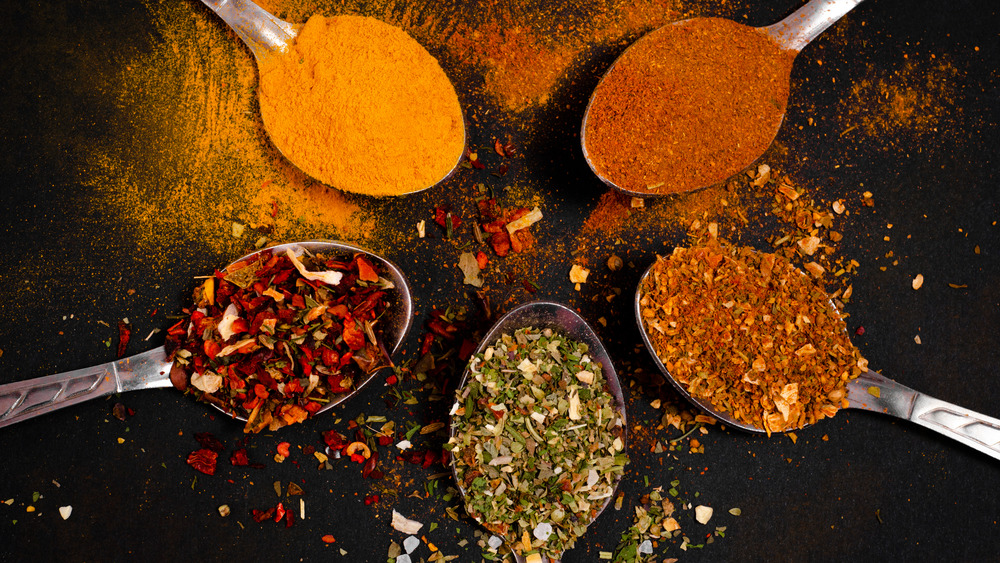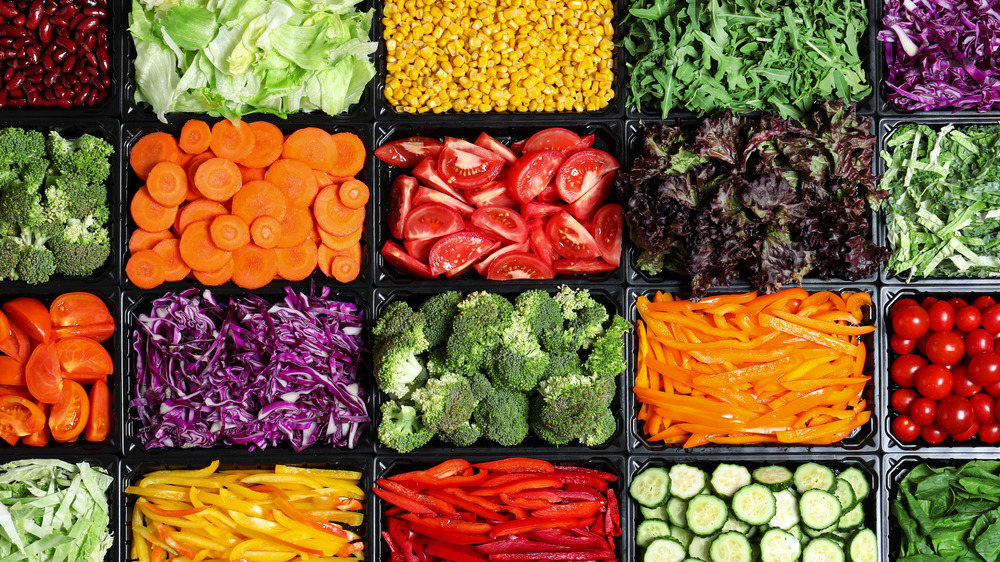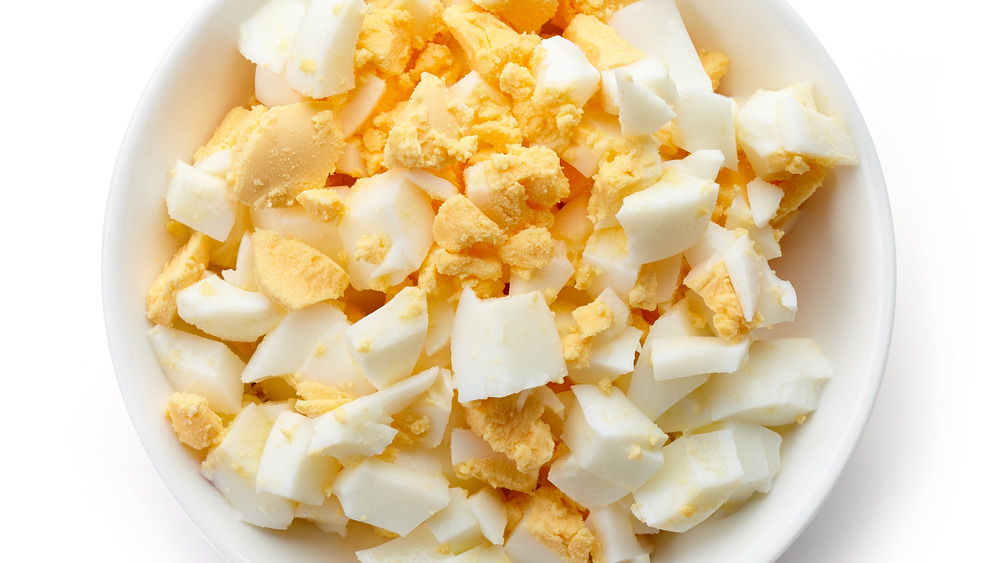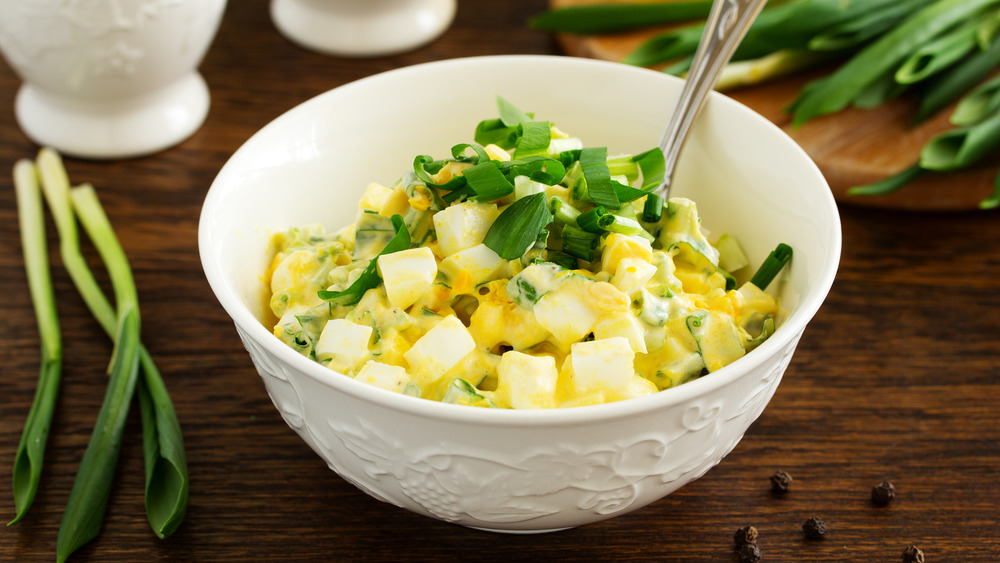Mistakes Everyone Makes With Their Egg Salad
Surf around any food or recipe site on the web, and you're likely to find a vast number of articles dedicated to the subject of egg salad. By some accounts, egg salad is one of the most searched and Googled foods on the internet, with more than 8.3 million search results coming up for the phrase "egg salad" alone.
Obviously, the dish has earned its incredible popularity. Yes, it's creamy and delicious. But it's also remarkably versatile. There are literally thousands of different ways you can make egg salad. And it can be served in countless forms — in a sandwich, or on lettuce greens, in a wrap, or on its own — at virtually any time of day or night.
If that weren't enough, egg salad is also super affordable to shop for, is easy to make, doesn't require any special tools or ingredients, is vegetarian-friendly, and is well tolerated by almost all children. Depending on how you prepare it, it can also be very healthy — low calorie, high protein, and appropriate for nearly any weight loss plan.
But as much as egg salad has going for it, it's not infallible. With the wrong choice of ingredients or wrong technique, it can wind up bland, watery, chalky, and downright nasty.
Luckily, even the mistakes that lead to bad egg salad can be easily avoided. Follow these tips and remedies for the mistakes everyone makes with their egg salad, and your next batch is sure to turn out a winner!
You're overcooking or undercooking your eggs
The foundation of a good egg salad is a well cooked hard-boiled egg. According to domestic wizard Martha Stewart, cooking a hard-boiled egg should be incredibly easy. Just place your eggs in a deep pot and fill it with water until the eggs are submerged under at least an inch of water. Then, bring the pot "to a boil over high heat, cover, remove from heat, and let stand 13 minutes."
When the eggs are done, immediately place them in ice cold water to stop the cooking process to ensure they'll come out of the shell easily when peeling.
Undercook your eggs by letting them heat for less than 12 minutes and you'll end up with a yolk that's runny and soft. Let the eggs cook for 6 to 10 minutes and you'll end up with an egg that's somewhere between soft- and hard-boiled and completely wrong for use in egg salad.
On the flip side, when you overcook your eggs, letting them heat for 14 minutes or longer, you risk the outside of your eggs turning green and them starting to taste of sulfur. According to The Incredible Egg, this is the result of a chemical reaction "between sulfur in the whites and iron in the yolks" that occurs when the eggs cook too long. Using the freshest eggs possible can eliminate the problem since fresher eggs have less alkaline whites, and are less likely to undergo chemical reactions during cooking.
You're having trouble peeling your eggs
When your hard-boiled egg is difficult to remove from the shell, it's not just frustrating — it can ruin your entire dish. You know the feeling. Sometimes hard-boiled eggs instantly release from their shells. And sometimes they become a total nightmare — sticking to the shell as you remove it, tearing off in chunks, and ultimately looking downright terrible once finally peeled.
The secret to helping eggs always peel easily out of their shell after cooking is making sure you cool them off quickly. Once your eggs have simmered for the recommended 13 minutes, author and health coach Elizabeth Rider recommends you immediately place them in ice water.
"Shocking them in ice-cold water stops the cooking process," she explained, "which not only yields more tender whites and a perfectly cooked yolk, it immediately cools the eggs which makes them easier to peel."
You can move your cooked eggs to a new bowl before icing them, or you can add ice to the pot you cooked them in. Either way, before you do, the folks at The Today Show have recommended another essential hack: after you've drained the hot water from the pot — and before you add the cold — gently shake your cooked eggs around the pot and bang them along its edges, creating fine cracks. These cracks allow cold water to enter the egg, stopping the cooking process even faster and making your eggs even easier to remove from their shells.
You're not using enough salt in your egg salad
Salt is a key ingredient for any egg-based dish, including egg salad. Whether you're using Hawaiian red salt or table salt, that flavor is essential for helping to make eggs taste rich and satisfying.
However you use it, according to Fine Cooking, "salt has the amazing ability to intensify agreeable tastes and diminish disagreeable ones."
While chef Gordon Ramsay has warned that adding salt to scrambled eggs at the wrong time can cause them to "go gray," you don't have to worry about such a problem with egg salad. Just make sure you get the salt in there at some point while you're making the salad!
In addition to improving your egg salad's flavor, salt can also help to keep your concoction from turning too watery. Salt helps to pull moisture from cooked eggs, in turn helping to keep your egg salad from turning watery.
Accidentally slip up and add too much salt to your egg salad? You can make your eggs palatable again by immediately dicing up some onions or celery and adding them to your eggs. Sometimes, the addition of a watery ingredient will be enough to make your dish taste less salty. If that doesn't work, you can also add more eggs to your salad to help dilute the salt. Or, you can even go so far as to rinse the salt off your eggs and make your salad again.
You're not using freshly ground black pepper in your egg salad
You know you should be using it. As GQ has jokingly pointed out, "literally every recipe ever written calls for [it]." So why are you still using pre-ground black pepper that comes in a can instead of the real, chef-approved, freshly ground stuff?
While packaged black pepper may provide a decent amount of heat to egg salad, Simply Recipes has pointed out that freshly ground black pepper is also "fruity and bright, and its interplay with different foods and textures is varied and nuanced."
Pre-ground black pepper also loses flavor over time, oxidizing in its can and losing significant nutritional benefits for your health as well. (An antioxidant found in black pepper called piperine may help to reduce risk for cancer, improve heart health, boost immunity, and even aid in digestion when consumed as part of a meal.) You're also better able to control the coarseness of freshly ground black pepper — extra fine for all-over flavor or big and chunky for a defined flavor punch.
Freshly ground black pepper is also significantly less likely to be filled with contaminants than packed, processed, ground black pepper. NPR has warned that packaged spices, including black pepper, often contain dirt, debris, and even rodent hairs.
And if all that weren't enough, GQ's Paula Forbes' final argument should be enough. "[Freshly ground black pepper] honestly make[s] your food taste so much better," she said.
Your mayo game could use some work in your egg salad
Like the debates over Coke vs. Pepsi and smooth peanut butter vs. chunky, the question of whether you should use Miracle Whip or traditional mayonnaise in foods like egg salad has divided many. Some prefer the sweet, slightly spicy flavor of Miracle Whip (which was originally rolled out for the 1933 World's Fair). Others stand by the salty, slightly tangy taste of a traditional mayonnaise like Hellmann's. Whichever camp you fall in to, know that Miracle Whip isn't actually mayonnaise — and it could impact the texture of your egg salad.
According to Real Simple, "the U.S. Food and Drug Administration requires that anything labeled 'mayonnaise' contain a minimum of 65 percent vegetable oil by weight." Although the exact oil content of Miracle Whip is a secret for proprietary reasons, it doesn't meet the mayo standard — even though it does contain the standard egg, soybean oil, vinegar, and water found in traditional mayonnaise.
While the mixture of fat and water in regular mayonnaise is firmly bonded together when the two are mixed with egg, be aware that regular and low-fat condiments like Miracle Whip don't have the same consistency, and are likely to break down over time, resulting in soggy egg salad.
Don't like the taste of mayo or Miracle Whip? Martha Stewart has suggested swapping an equal amount of ricotta, yogurt, cottage cheese, hummus, or even mashed avocado into your egg salad in its place.
You're only using prepared yellow mustard in your egg salad
While most egg salad recipes call for mustard, if you're only using a bright yellow prepared mustard (like French's), then you — and your egg salad — are missing out on a world of flavors and possibilities.
Celebrity chef Richard Blais of Top Chef fame has said that "Mustard — in any form" is one of his favorite foods because of its ability to add subtle acidity and spice to any dish.
When it comes to using mustard in egg salad, Christine Rooney of The Rustic Foodie has said that she prefers smooth Dijon. "I would avoid the grainy country-style mustard as it will change the texture of the dressing," she cautioned. Spicy brown mustard and sweet honey Dijon are also great options.
Whole grain mustard is another ideal texture and flavor-boosting option for egg salads. As the name suggests, this condiment is made of whole mustard seeds that have been ground just enough to form a thick, coarse paste, but not so much that they fully break down to be as smooth as prepared mustards (via Serious Eats).
For the most potent mustard bite, try dried ground mustard in your egg salad. A staple of the spice aisle, "a tablespoon of ground mustard is much hotter than a tablespoon of prepared mustard," according to The Spruce Eats, since prepared mustard also often contains added ingredients such as vinegar, turmeric, paprika, salt, and garlic.
You're not using relish or diced pickle in your egg salad
Egg salad's classic — and highly craveable — flavor comes from more than mayo, eggs, and spices. You also need a good tangy acidic punch — and relish and pickles are the ideal way to get it.
One of the oldest mass-produced condiments in the U.S., Saveur has reported that H. J. Heinz (of Heinz ketchup fame) first started packaging and selling "India Relish" in 1889.
"The original secret recipe, loosely based on traditional Indian relishes, featured a sugared and vinegared mix of pickled cucumbers, green tomatoes, cauliflower, white onions, red bell peppers, celery, and mustard seed, plus cinnamon and allspice," the site said.
Today, you'll find a wide range of relishes in most grocery stores – dill, sweet, spicy, Chicago-style (which is often neon green), and more, plus relishes made with everything from corn and onions to red peppers and even jalapenos. A tablespoon or two of all these relish variations works perfectly in virtually all egg salads.
If you're looking for more crunch in your egg salad, try dicing up some of your favorite pickles instead. Bread and butter pickles, dill pickles, and gherkins are all ideal options. At Easy Weeknight Recipes, diced dill pickle is the secret to a delectable egg salad. "The pickles add crunch and the dill adds freshness," the site said, creating a "creamy egg salad with chunks of juicy pickles in each and every bite!"
Your egg salad is bland -- you're not using the right flavor-boosting spices
Eggs and mayo are a miraculous pair of foods in that they can adapt and mesh with virtually any flavor combination you throw their way. Because of this, coming across a bland, boring egg salad should almost be criminal. There's simply no excuse for not adding one or more of your favorite spices to any egg salad you make, elevating any ordinary dish to extraordinary.
The experts at Cooking Light recommend keeping calories in your egg salad low by playing with spices. For example, the site's "herb egg salad" contains plentiful amounts of fresh basil, parsley, and dill. For a more international tasting dish, they also recommend a curry and red bell pepper egg salad containing a teaspoon of (you guessed it): curry.
"The curry powder compliments the creamy egg base while the peppers add a bright crunch," wrote foodie and author Katherine Flynn.
At Lana's Cooking, the herbed egg salad contains cilantro, parsley, and capers, while BetterNutrition's egg salad is bursting with flavor due to the addition of fresh rosemary.
Thyme is another good option for adding flavor to egg salad. At Budget Bytes, they've paired it with fresh lemon juice for a salad that's "light, fresh, and summery!" According to chef and cookbook author Beth Moncel who runs the site, "the combination of lemon juice and fresh herbs provides tang and a light herbal flavor to contrast the rich eggs and mayonnaise based dressing."
You're not adding mix-ins to amp up the flavor of your egg salad
Good egg salad is more than just hard-boiled eggs, mayo, and spices. Like green salads and pasta salads, you can add in an almost unlimited number of ingredients — and whatever you create will likely be pretty tasty.
For a dish that's reminiscent of breakfast, try adding bacon crumbles to your egg salad. The Food Network suggests cooking six slices and then crumbling them into your egg salad while mixing it. The network's foodies also suggest freshly chopped chives, chunks of ripe avocado, and diced tomato as worthy egg salad additions.
At Southern Living, chef Micah Leal adds diced potatoes to his egg salad, creating an egg salad/potato salad hybrid.
In a discussion on Chowhound, home chefs have offered nearly everything but the kitchen sink as possible delicious egg salad mix-ins. Popular suggestions include diced onion, diced celery, red pepper slices, chunks of ham, diced grilled chicken, anchovy, walnuts, capers, olives (black and green), and even canned tuna.
When adding mix-ins to your egg salad, try keeping the ingredients related so they create a more cohesive dish. Eating Well has some great examples of egg salad meals. You can go for a "Sweet Southern egg salad" that combines celery, gherkin pickles, and sweet onions to taste. Or try "Cobb egg salad," which pairs egg salad with bacon, blue cheese, and avocado. "Niçoise egg salad" — made with green beans, tuna and olives — is another hearty and mouthwatering option.
You're not mixing the egg salad to the perfect consistency
For a rustic, chunky homestyle egg salad with large pieces of egg, try adding all your roughly chopped, large ingredients into a bowl, one by one, and then gently stirring everything together until well blended. The editors at Martha Stewart take a vastly different approach in their how-to video. They also recommend adding all your salad ingredients to a bowl but they suggest keeping your peeled, hard-boiled eggs whole. Since the eggs aren't diced, you can then use a pastry dough cutter or potato masher to crush them into the other ingredients, creating an incredibly rustic and homey egg salad as you churn and chop the egg mixture.
For a light, fluffy, blended egg salad, you'll want to take almost the exact opposite approach. Everything you want to include in your salad should be chopped as fine as possible. Then, instead of adding everything to a bowl, you dump it all into a high-power blender or food processor.
At Food 52, they compare this technique to the Japanese-style of making the uber-creamy egg salad used in a sandwich called Tamago Sando. Once your ingredients are in the blender, puree for a few seconds, the site advised. Check your spice levels and make sure everything tastes right, then pulse again. "You won't be processing it for too long — just enough for the egg salad to look smooth and unified."
You're letting leftover egg salad sit around too long
Whether you're dining on egg salad alone or you've made a big batch of it for a picnic or holiday meal, know that bacteria can grow quickly in the creamy food the longer it sits out and the warmer it gets. Temperatures between 40 and 140 degrees Fahrenheit are all warm enough to encourage bacterial growth, so even if your egg salad is sitting out in a cool house (compared to outside on a sunny picnic table), it can still put your health at risk the longer it remains exposed to warm temperatures. According to Still Tasty, "egg salad should be discarded if left out for more than 2 hours at room temperature."
Kept in the fridge, egg salad is a bit more stable. Southern Living has reported that egg salad that is properly covered and chilled in the refrigerator needs to be eaten within five days. "This rule also applies to similar mayonnaise-based salads like chicken, tuna, ham, and macaroni salads," the magazine said.
Don't think you can freeze excess egg salad to keep it safe to eat either. Both eggs and mayo break down in the freezer, leaving a rubbery, watery mess when thawed.
Curious if your old egg salad is still good? Don't taste it! If you notice an add smell or appearance, it's time to throw it away and start a new batch. Your stomach will thank you!
